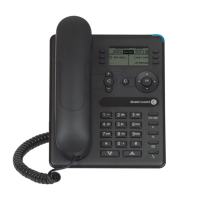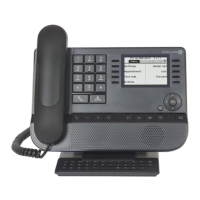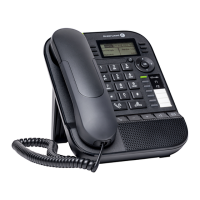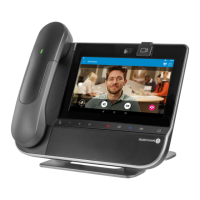8254/8234 DECT Handset
– OXO Con
nect
- Quick guide
Related Documentation - Other languages for these Safety and Regulatory Instructions and User Documentation are available at the following Web site https://www.al-enterprise.com/products.
8AL90386ENABed01 - The Alcatel-Lucent name and logo are trademarks of Nokia used under license by ALE. - Copyright © ALE International 2021
Battery charge level ( > > > ).
In charge (Flashing icon).
New event(s) - callback request, voice mail, text
mail, missed call.
Progressive ringing enabled.
Loudspeaker on (in conversation).
Mute on (in conversation).
Call diversion activated.
Radio reception quality - Normal power mode.
Radio reception quality - 50 mW Power mode.
Access MENU. It provides access to all the functions
available on your system.
Icons depend on the connected system. Some icons may not be
displayed on your phone. All icons are described in their
unselected state. When selected, the icons are displayed in white
on a blue background.
Manage your personal directory and access the
company directory.
Call back one of the last numbers dialed.
Divert your calls to voicemail or another number.
Cancelling all forwards.
Access the messaging portal.
Consult and send voice and text messages.
Access the call log.
Answer a call intended for another telephone.
Schedule an appointment or a permanent appointment.
Access the services configuration of the handset
(melody, ring level, auto answer, language, password).
Access the general settings of the phone (audio
settings, keys, screensaver, dock settings, language,
select system, reset settings, status).
Installation (password protected).
The following menu is only available on the 8254 DECT Handset:
Alarm settings menu (password protected).
Making a call. The example is given for the first call
(line 1).
Receiving a call. The example is given for the first call
(line 1).
Call on hold. The example is given for the first call (line
1). When you make a second call, your first contact is
put on hold.
Making a call. The example is given for the first call
(line 1).
Accessing the directories.
Switching to DTMF signals.
Forwarding calls to your voice message service.
Parking an external communication.
Additional options (Features depending on the system).
Access the messaging portal
Answered incoming calls.
Redialing (Long press).
Send the call.
Switching between two outgoing calls.
Ignore the call.
End the call.
Calling from your personal directory (PersSpDial).
Calling your caller by name (company directory).
Programming your personal directory (PersSpDial).
Call from call log (All incoming, outgoing, missed or
unanswered calls are displayed in the call log).
Consulting text messages.
Sending text messages.
Consulting your voice mailbox.
Sending a recorded message to a number or a
distribution list.
Divert your calls to another number.
Diverting calls to your voice mailbox.
Different types of diversions.
Switching to DTMF signals.
Modifying your personal code.
Adjusting the ringer volume.
Access the ringer and vibrate adjustment feature.
Programming an appointment reminder.
Locking features on your terminal.
